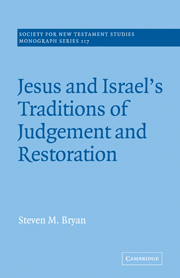Book contents
- Frontmatter
- Contents
- Acknowledgements
- Abbreviations and citation conventions
- Note on texts used
- 1 Introduction
- 2 Jesus and signs of national restoration
- 3 Jesus and the Scriptures of Israel
- 4 Jesus and the restoration traditions of Israel
- 5 Jesus and the purity of Israel
- 6 Jesus and the eschatological Temple
- 7 Conclusion
- Bibliography
- Index of passages
- Index of subjects
2 - Jesus and signs of national restoration
Published online by Cambridge University Press: 22 September 2009
- Frontmatter
- Contents
- Acknowledgements
- Abbreviations and citation conventions
- Note on texts used
- 1 Introduction
- 2 Jesus and signs of national restoration
- 3 Jesus and the Scriptures of Israel
- 4 Jesus and the restoration traditions of Israel
- 5 Jesus and the purity of Israel
- 6 Jesus and the eschatological Temple
- 7 Conclusion
- Bibliography
- Index of passages
- Index of subjects
Summary
In this chapter and the next, I focus on negative elements in Jesus' response to Jewish national restorationism. I will attempt to show that certain constituent features, themes, and assumptions of this restorationism which had been generated by eschatological reflection on Israel's sacred traditions were challenged or reworked by Jesus in the light of alternative traditions. Moreover, in doing so, he not only rejected certain elements of Jewish restorationism but altered them in such a way as to make them serve a message of national judgement.
The particular concern of the present chapter is to trace the role and meaning of signs within Jewish expectations of restoration and to assess Jesus' response to and use of this feature of national restorationism.
Jesus' assertions of obvious but unrecognized fulfilment
Jesus' critique of the rejection of his message of eschatological fulfilment
Unless we reject large swaths of the Jesus tradition, the following propositions are firm: (1) Jesus preached the arrival or imminent arrival of the time of fulfilment; (2) Jesus' ministry stirred broad interest but his message did not finally gain wide acceptance; (3) Jesus believed that the rejection of his message was morally culpable.
Inasmuch as Jesus believed that the rejection of his message of eschatological fulfilment was blameworthy, it is clear that he took the reality which he announced to be obvious and discernible. Such a perspective lies behind a number of parables (e.g. the parable of the wedding feast) and much of Jesus' interaction with the Jewish leaders.
- Type
- Chapter
- Information
- Publisher: Cambridge University PressPrint publication year: 2002
- 1
- Cited by



